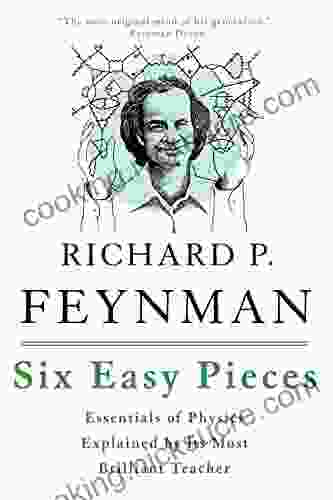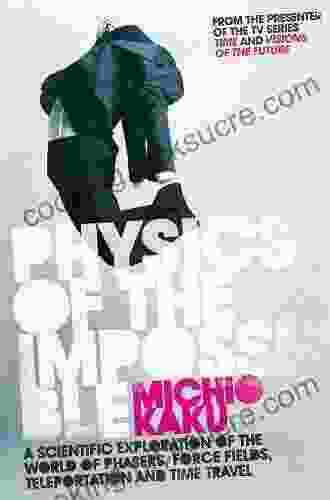Essentials of Physics Explained by Its Most Brilliant Teacher

Physics is the study of matter and energy and their interactions. It is a fundamental science that has applications in many fields, including engineering, medicine, and technology. Physics can be a challenging subject, but understanding its essentials is essential for success in these fields and many more.
In this article, we will explore the essentials of physics, as explained by some of the most brilliant teachers in the field. We will cover topics such as motion, energy, forces, and waves. We will also provide tips for understanding physics and how to apply it to real-world problems.
MotionMotion is the change in position of an object over time. It can be described by several different quantities, including speed, velocity, and acceleration.
4.6 out of 5
| Language | : | English |
| File size | : | 1948 KB |
| Text-to-Speech | : | Enabled |
| Screen Reader | : | Supported |
| Enhanced typesetting | : | Enabled |
| X-Ray | : | Enabled |
| Word Wise | : | Enabled |
| Print length | : | 180 pages |
- Speed is the rate at which an object is moving. It is measured in meters per second (m/s).
- Velocity is the speed of an object in a specific direction. It is measured in meters per second in a specific direction (m/s).
- Acceleration is the rate at which an object's velocity is changing. It is measured in meters per second squared (m/s^2).
The laws of motion are a set of three laws that describe the relationship between an object's motion and the forces acting on it. The three laws of motion are:
- Newton's First Law: An object at rest will remain at rest unless acted on by an unbalanced force. An object in motion will remain in motion with the same speed and in the same direction unless acted on by an unbalanced force.
- Newton's Second Law: The acceleration of an object is directly proportional to the net force acting on the object and inversely proportional to the mass of the object.
- Newton's Third Law: For every action, there is an equal and opposite reaction.
EnergyEnergy is the ability to do work. It exists in many different forms, including kinetic energy, potential energy, and thermal energy.
- Kinetic energy is the energy of motion. It is measured in joules (J).
- Potential energy is the energy stored in an object due to its position or condition. It is measured in joules (J).
- Thermal energy is the energy of heat. It is measured in joules (J).
The law of conservation of energy states that energy cannot be created or destroyed, only transferred or transformed from one form to another.
ForcesA force is a push or pull that acts on an object. Forces can cause objects to move, stop moving, or change direction.
There are many different types of forces, including gravitational force, electromagnetic force, and nuclear force.
- Gravitational force is the force that attracts objects with mass toward each other. It is the force that keeps us on the ground and that causes objects to fall.
- Electromagnetic force is the force that acts between charged particles. It is the force that holds atoms together and that causes magnets to attract or repel each other.
- Nuclear force is the force that holds the nucleus of an atom together. It is the strongest of the four fundamental forces.
WavesA wave is a disturbance that travels through a medium. Waves can be classified as either mechanical waves or electromagnetic waves.
- Mechanical waves require a medium to travel through. Examples of mechanical waves include sound waves and water waves.
- Electromagnetic waves do not require a medium to travel through. Examples of electromagnetic waves include light waves and radio waves.
Waves are characterized by several different properties, including wavelength, frequency, and amplitude.
- Wavelength is the distance between two consecutive crests or troughs of a wave. It is measured in meters (m).
- Frequency is the number of waves that pass a given point in one second. It is measured in hertz (Hz).
- Amplitude is the height of a wave from its trough to its crest. It is measured in meters (m).
How to Understand PhysicsPhysics can be a challenging subject, but there are several things you can do to make it easier to understand.
First, it is important to have a strong foundation in mathematics. Physics is a mathematical science, and you will need to be able to use math to solve problems.
Second, it is important to be able to visualize concepts. Physics is often about understanding how things move and interact, and being able to visualize these concepts will help you to understand them better.
Third, it is important to be persistent. Physics can be difficult, but if you are persistent and work hard, you will eventually be able to understand it.
How to Apply Physics to Real-World ProblemsPhysics can be applied to solve many real-world problems. For example, physics can be used to design bridges, buildings, and airplanes. It can also be used to develop new technologies, such as lasers and solar panels.
To apply physics to a real-world problem, you need to first understand the problem and the physics involved. Once you understand the problem and the physics, you can use your physics knowledge to develop a solution.
Physics is a fundamental science that has applications in many fields. Understanding the essentials of physics is essential for success in these fields and many more. In this article, we have explored the essentials of physics, as explained by some of the most brilliant teachers in the field. We have covered topics such as motion, energy, forces, and waves. We have also provided tips for understanding physics and how to apply it to real-world problems.
4.6 out of 5
| Language | : | English |
| File size | : | 1948 KB |
| Text-to-Speech | : | Enabled |
| Screen Reader | : | Supported |
| Enhanced typesetting | : | Enabled |
| X-Ray | : | Enabled |
| Word Wise | : | Enabled |
| Print length | : | 180 pages |
Do you want to contribute by writing guest posts on this blog?
Please contact us and send us a resume of previous articles that you have written.
 Fiction
Fiction Non Fiction
Non Fiction Romance
Romance Mystery
Mystery Thriller
Thriller SciFi
SciFi Fantasy
Fantasy Horror
Horror Biography
Biography Selfhelp
Selfhelp Business
Business History
History Classics
Classics Poetry
Poetry Childrens
Childrens Young Adult
Young Adult Educational
Educational Cooking
Cooking Travel
Travel Lifestyle
Lifestyle Spirituality
Spirituality Health
Health Fitness
Fitness Technology
Technology Science
Science Arts
Arts Crafts
Crafts DIY
DIY Gardening
Gardening Petcare
Petcare Simon Garfield
Simon Garfield Andrew Doughty
Andrew Doughty Thomas Berger
Thomas Berger Wolfgang Hohlbein
Wolfgang Hohlbein Martin Rooney
Martin Rooney Romney Steele
Romney Steele Ken Gullette
Ken Gullette Sandra Glosser
Sandra Glosser Mike Davenport
Mike Davenport Bruce Bowlen
Bruce Bowlen Susan Williams White
Susan Williams White Raymond Coppinger
Raymond Coppinger Terry Ann Williams Richard
Terry Ann Williams Richard Bruce Mcnall
Bruce Mcnall Tim Wharnsby
Tim Wharnsby Leisy J Abrego
Leisy J Abrego Andy Bull
Andy Bull Sarah Outen
Sarah Outen Jen Calonita
Jen Calonita Ralph Zuranski
Ralph Zuranski A J Carlisle
A J Carlisle Kjartan Poskitt
Kjartan Poskitt J E Lendon
J E Lendon Andrew Duncan
Andrew Duncan Michael T Nygard
Michael T Nygard Sorin Dumitrascu
Sorin Dumitrascu Jim Curran
Jim Curran Jefferson Hawkins
Jefferson Hawkins Jim Apfelbaum
Jim Apfelbaum Andrej Spec
Andrej Spec Richard P Feynman
Richard P Feynman James Lyons Weiler
James Lyons Weiler Jason Zemcik
Jason Zemcik Jenn Brandt
Jenn Brandt Mike Cyra
Mike Cyra Rolf Potts
Rolf Potts Leslie Vedder
Leslie Vedder Michael Anderle
Michael Anderle Nancy Mather
Nancy Mather Andrea Wachter
Andrea Wachter Steve Sheinkin
Steve Sheinkin Andrea Komlosy
Andrea Komlosy Luigi Gabriele Conti
Luigi Gabriele Conti Gary Thomas
Gary Thomas Steven Poses
Steven Poses Julie Miller
Julie Miller Andrea Cataldo
Andrea Cataldo Tim Ryan
Tim Ryan Luke Rosiak
Luke Rosiak Julie Powers
Julie Powers Patrick Hatt
Patrick Hatt Minal Hajratwala
Minal Hajratwala David Scott
David Scott Ann Gadzikowski
Ann Gadzikowski Jennifer Blair
Jennifer Blair Marvin L Bittinger
Marvin L Bittinger Ian O Connor
Ian O Connor George E P Box
George E P Box Tom Siegfried
Tom Siegfried Andrea Bemis
Andrea Bemis James Geary
James Geary Future Publishing
Future Publishing Ewen Levick
Ewen Levick Stephen Chbosky
Stephen Chbosky Peter Mcbride
Peter Mcbride Antonio Iturbe
Antonio Iturbe Riley Black
Riley Black Robin Mamlet
Robin Mamlet Department Of Defense
Department Of Defense Jennifer L Armentrout
Jennifer L Armentrout E K Johnston
E K Johnston Necoco
Necoco Noel Janis Norton
Noel Janis Norton Jack Hunnicutt
Jack Hunnicutt Robert Bacal
Robert Bacal Steven Johnson
Steven Johnson John Morton
John Morton Francesca Zappia
Francesca Zappia Robyn Sheldon
Robyn Sheldon Victoria Ortiz
Victoria Ortiz Stuart L Kaplan M D
Stuart L Kaplan M D Andrew Feinberg
Andrew Feinberg Andrea Gonzales
Andrea Gonzales Leslie Sokol
Leslie Sokol Clayton Everline
Clayton Everline Chiara Marletto
Chiara Marletto Galit Shmueli
Galit Shmueli Eugene Raikhel
Eugene Raikhel Paul Stamets
Paul Stamets Frances Evesham
Frances Evesham Steven Arms
Steven Arms Sid Thatte
Sid Thatte David Abram
David Abram Marta Szabo
Marta Szabo Catherine Montgomery
Catherine Montgomery M D Johnson
M D Johnson Nic Oatridge
Nic Oatridge Ben Orlin
Ben Orlin Lauren Daniels
Lauren Daniels Andre Watson
Andre Watson Andrea Curtis
Andrea Curtis Kristin Briney
Kristin Briney Jon Gillespie Brown
Jon Gillespie Brown Michael Judge
Michael Judge Joe Posnanski
Joe Posnanski Hayley Campbell
Hayley Campbell Erich Neumann
Erich Neumann Lonely Planet
Lonely Planet Jenny Mackay
Jenny Mackay Gabby Rivera
Gabby Rivera Caren Van Slyke
Caren Van Slyke Tod Schimelpfenig
Tod Schimelpfenig Raymond E Feist
Raymond E Feist Lisa Bond
Lisa Bond Christopher Sommer
Christopher Sommer Victoria Schwab
Victoria Schwab Tillie Walden
Tillie Walden Lori Shandle Fox
Lori Shandle Fox Stacey Little
Stacey Little Galen Wolf
Galen Wolf Peter Boardman
Peter Boardman Sudhir Shirwadkar
Sudhir Shirwadkar Emily Henry
Emily Henry Dylan Norton
Dylan Norton Meiso
Meiso Gaurav Suri
Gaurav Suri James A Middleton
James A Middleton Jordan Romero
Jordan Romero Kathryne Kennedy
Kathryne Kennedy Matt Fulks
Matt Fulks Rita Jablonski
Rita Jablonski Jason Louv
Jason Louv Gillian Tett
Gillian Tett Paul Rooyackers
Paul Rooyackers C L Werner
C L Werner 24th Edition Kindle Edition
24th Edition Kindle Edition Arlo Adams
Arlo Adams Deaver Brown
Deaver Brown Jakub Marian
Jakub Marian Jay Greeson
Jay Greeson Harriet Brown
Harriet Brown Roger Atwood
Roger Atwood Tracy Townsend
Tracy Townsend Hugh Raffles
Hugh Raffles Frans De Waal
Frans De Waal Paco Underhill
Paco Underhill Greg Ruth
Greg Ruth Vin T Sparano
Vin T Sparano Bettina Bonifatti
Bettina Bonifatti Richard Heinberg
Richard Heinberg Hasok Chang
Hasok Chang Jaak Panksepp
Jaak Panksepp Robert Jay Lifton
Robert Jay Lifton Nancy B Rapoport
Nancy B Rapoport Erica Hoke
Erica Hoke Kelly Tyler Lewis
Kelly Tyler Lewis Arianna Astuni
Arianna Astuni Sandy Stott
Sandy Stott Daniel P Murphy
Daniel P Murphy Ronald D Davis
Ronald D Davis Sue Fierston
Sue Fierston Donna Bollinger
Donna Bollinger Anne Marie Meyer
Anne Marie Meyer Laurie Seale
Laurie Seale Jason Welker
Jason Welker Andrea Cremer
Andrea Cremer Mandy Baggot
Mandy Baggot James Dodson
James Dodson Kylie Lee Baker
Kylie Lee Baker Andrew Goliszek
Andrew Goliszek Chris Salisbury
Chris Salisbury Joey Miller Msw Lcsw
Joey Miller Msw Lcsw Jack Purdum
Jack Purdum C B Lee
C B Lee Claire Maxted
Claire Maxted Anne Bogel
Anne Bogel Jennifer Anne Davis
Jennifer Anne Davis Chris Lilly
Chris Lilly D Harvey
D Harvey Peter David
Peter David Nick Peters
Nick Peters Mason Deaver
Mason Deaver Rachel Hawkins
Rachel Hawkins Shane Ryan
Shane Ryan Andrea Hudy
Andrea Hudy Dot Edu
Dot Edu Elizabeth S Trafalgar
Elizabeth S Trafalgar Namina Forna
Namina Forna Mary Keith Piasecki
Mary Keith Piasecki Kiersten White
Kiersten White Bridget Portmann
Bridget Portmann Brian C Muraresku
Brian C Muraresku Christos Lynteris
Christos Lynteris Dani Jacobs
Dani Jacobs Malinda Lo
Malinda Lo Andrew St Pierre White
Andrew St Pierre White Nikola Tesla
Nikola Tesla Gemma Rogers
Gemma Rogers Pat Wray
Pat Wray James Turnbull
James Turnbull Pliny The Elder
Pliny The Elder C L Mississippi Morgan
C L Mississippi Morgan Rachel Meltzer Warren
Rachel Meltzer Warren Lilith Starr
Lilith Starr Ola Ola
Ola Ola Joe Cavallaro
Joe Cavallaro Cliff Wilson
Cliff Wilson Charles H Hapgood
Charles H Hapgood Linda Eyre
Linda Eyre Bisco Hatori
Bisco Hatori Joe Wells
Joe Wells Ian Tattersall
Ian Tattersall Florent Buisson
Florent Buisson Sheila Jasanoff
Sheila Jasanoff Stephen Wiggins
Stephen Wiggins Patrick Mouratoglou
Patrick Mouratoglou Marta Obiols Llistar
Marta Obiols Llistar Andrew Greiner
Andrew Greiner Arous Brocken
Arous Brocken Charlotte Elkins
Charlotte Elkins Michael Hermann
Michael Hermann Kristine Papin Morris
Kristine Papin Morris Andrea Olson
Andrea Olson Andrew Beyer
Andrew Beyer Jeremy Freese
Jeremy Freese John Gilbert
John Gilbert Barbara Merry
Barbara Merry Sarah Castille
Sarah Castille Shaun Assael
Shaun Assael Kailin Gow
Kailin Gow S Fatou
S Fatou Guillermo Ferrara
Guillermo Ferrara Joseph Ledoux
Joseph Ledoux Greg Presto
Greg Presto Rich Luhr
Rich Luhr Melissa Caughey
Melissa Caughey David Alloway
David Alloway Victoria Allman
Victoria Allman Gregory Curtis
Gregory Curtis Richard Munson
Richard Munson Thomas Meyer
Thomas Meyer Brenda Reed Pilcher
Brenda Reed Pilcher Usa Pickleball Association
Usa Pickleball Association George Mahood
George Mahood Joseph Terry
Joseph Terry Isabel Sterling
Isabel Sterling John Bantin
John Bantin Dorothy Pang
Dorothy Pang Josh Tabor
Josh Tabor Will Thornton
Will Thornton Craig Custance
Craig Custance Laura Lincoln Maitland
Laura Lincoln Maitland Steven J Matthiesen
Steven J Matthiesen Metin Bektas
Metin Bektas Patsy M Lightbown
Patsy M Lightbown James Mallory
James Mallory Sameera Khan Rd Pa C
Sameera Khan Rd Pa C Lundy Bancroft
Lundy Bancroft Prasad Raju V V N R Pathapati
Prasad Raju V V N R Pathapati Marcus Felson
Marcus Felson Rob Summers
Rob Summers Rachael Chapman
Rachael Chapman Nick Marshall
Nick Marshall Steven M Fiser
Steven M Fiser Aldous Huxley
Aldous Huxley Jeff Davis
Jeff Davis J David Logan
J David Logan Jamie Ivey
Jamie Ivey Kyle Keegan
Kyle Keegan Giada De Laurentiis
Giada De Laurentiis Brian Azzarello
Brian Azzarello Jonathan Clements
Jonathan Clements Laurie Ann Thompson
Laurie Ann Thompson Brock Eide
Brock Eide Eric Engle
Eric Engle Luke Hohmann
Luke Hohmann Big Daddy Ozone
Big Daddy Ozone Nancy Mcwilliams
Nancy Mcwilliams Steve Anthony Tallon
Steve Anthony Tallon Rashid Khalidi
Rashid Khalidi Robin Hobb
Robin Hobb Garcilaso De La Vega
Garcilaso De La Vega Keith Sutton
Keith Sutton Mary Jane Sterling
Mary Jane Sterling Lars Muhl
Lars Muhl Mark Mcconville
Mark Mcconville Neil Oliver
Neil Oliver L Michele Issel
L Michele Issel Steve Caplin
Steve Caplin Trish Allison
Trish Allison James Rebanks
James Rebanks Sara Manning Peskin
Sara Manning Peskin Daniel Shiffman
Daniel Shiffman Michio Kaku
Michio Kaku Jay Annelli
Jay Annelli Laura Domino
Laura Domino Loren Pope
Loren Pope Thomas S Kuhn
Thomas S Kuhn Kristen Thone
Kristen Thone Oliver Perkins
Oliver Perkins Robert Hamill
Robert Hamill Robert B Yonaitis
Robert B Yonaitis Adam Mansbach
Adam Mansbach Brad Schoenfeld
Brad Schoenfeld Dr Gabriel Peter Salgo
Dr Gabriel Peter Salgo Leigh Bardugo
Leigh Bardugo Suzy Ashworth
Suzy Ashworth Carrie Ryan
Carrie Ryan Becky Lomax
Becky Lomax Ronald W Doerfler
Ronald W Doerfler Marissa Meyer
Marissa Meyer Bill O Neill
Bill O Neill Michele Leathers
Michele Leathers Elizabeth Marshall Thomas
Elizabeth Marshall Thomas George Christian Pappas
George Christian Pappas David Montgomery
David Montgomery Richard Maury
Richard Maury Ivan Pastine
Ivan Pastine Christine Heppermann
Christine Heppermann Bhavesh Mamtani
Bhavesh Mamtani Leslie Morgan Steiner
Leslie Morgan Steiner Zak Mt Standridge
Zak Mt Standridge Robin Ha
Robin Ha Rupert Sheldrake
Rupert Sheldrake Whitney Nelson
Whitney Nelson Christine Balaz
Christine Balaz Robin Satty
Robin Satty Marcus A Pfeiffer
Marcus A Pfeiffer Daniel Humm
Daniel Humm Richard Bolstad
Richard Bolstad Rashers Tierney
Rashers Tierney Andrew Blauner
Andrew Blauner Stan Tekiela
Stan Tekiela David W Brown
David W Brown Pietro Matracchi
Pietro Matracchi Timothy Johnson
Timothy Johnson Jed Z Buchwald
Jed Z Buchwald Chris Mcmullen
Chris Mcmullen Course Hero
Course Hero Susanna Kearsley
Susanna Kearsley Serena Valentino
Serena Valentino Andrew Brown
Andrew Brown John Ramirez
John Ramirez Elizabeth S Meckes
Elizabeth S Meckes Kenneth S Shultz
Kenneth S Shultz Andrea Flores
Andrea Flores Mara Vorhees
Mara Vorhees Dayton O Hyde
Dayton O Hyde Cathal Armstrong
Cathal Armstrong Robert Sky Allen Ph D
Robert Sky Allen Ph D Kelsie Stelting
Kelsie Stelting Karen Tranberg Hansen
Karen Tranberg Hansen 18th Edition Kindle Edition
18th Edition Kindle Edition Rick Heard
Rick Heard Laird Hamilton
Laird Hamilton Bernard A Chavis
Bernard A Chavis Bernard Craw
Bernard Craw Joseph Bruchac
Joseph Bruchac V E Schwab
V E Schwab Christina Kim
Christina Kim Jacqueline Edmondson
Jacqueline Edmondson Roland Martin
Roland Martin Ed Willes
Ed Willes Steven H Weintraub
Steven H Weintraub Connie J Wells
Connie J Wells Joelle Charbonneau
Joelle Charbonneau Rob Taylor
Rob Taylor Bernard Moitessier
Bernard Moitessier Candace Clark Trinchieri
Candace Clark Trinchieri Dana Mccullough
Dana Mccullough Melissa Reynolds
Melissa Reynolds Tom Lecompte
Tom Lecompte Tamara Ireland Stone
Tamara Ireland Stone Richard N Aufmann
Richard N Aufmann William F Sensakovic
William F Sensakovic Bruce D Perry
Bruce D Perry Tom Lodziak
Tom Lodziak Seth Reichelson
Seth Reichelson Brandon Mull
Brandon Mull Jim Shea
Jim Shea Vertamae Smart Grosvenor
Vertamae Smart Grosvenor Rizwan Virk
Rizwan Virk James Fox
James Fox Jimmy Elliott
Jimmy Elliott Wendy Heard
Wendy Heard Richard Bellman
Richard Bellman April Vahle Hamel
April Vahle Hamel Geoffrey Wolff
Geoffrey Wolff Paul Abell
Paul Abell Bonita Norris
Bonita Norris Mira Kirshenbaum
Mira Kirshenbaum Linda Anne Silvestri
Linda Anne Silvestri Karen Robson
Karen Robson James R Morrow Jr
James R Morrow Jr Jenna Miscavige Hill
Jenna Miscavige Hill Matt Richtel
Matt Richtel Gerald A Moore Sr
Gerald A Moore Sr Mike Gauthier
Mike Gauthier Roberto Pedreira
Roberto Pedreira Gwendolyn Griffith Lieuallen
Gwendolyn Griffith Lieuallen Ben Doughty
Ben Doughty David Borgenicht
David Borgenicht Ruby Walker
Ruby Walker Sunny Anderson
Sunny Anderson Charles Szypszak
Charles Szypszak Mark Hume
Mark Hume Bob Mayer
Bob Mayer Benedict Carey
Benedict Carey Doug Swisher
Doug Swisher Elizabeth Clor
Elizabeth Clor Ken Blanchard
Ken Blanchard Steve Scott
Steve Scott James Willstrop
James Willstrop Donald S Murray
Donald S Murray Stephanie Cacioppo
Stephanie Cacioppo Robert H Miller
Robert H Miller Kirby Arnold
Kirby Arnold Paul Kalas
Paul Kalas Gabrielle Coleman
Gabrielle Coleman Lena Shev
Lena Shev Rachel Atwood
Rachel Atwood Joseph Luzzi
Joseph Luzzi Sean Pidgeon
Sean Pidgeon Jonathan Cummings
Jonathan Cummings Maria Konnikova
Maria Konnikova Kerri Andrews
Kerri Andrews Margaret Thorsborne
Margaret Thorsborne Kindra Gordon
Kindra Gordon W J Hendry
W J Hendry Christian Keur
Christian Keur Denise Riebe
Denise Riebe Carmen Micsa
Carmen Micsa Kelly Oliver
Kelly Oliver Michael S Malone
Michael S Malone William Ritter
William Ritter Paulette F C Steeves
Paulette F C Steeves Kathleen Dean Moore
Kathleen Dean Moore James Branch Cabell
James Branch Cabell Terence Callery
Terence Callery Anna Holmwood
Anna Holmwood Annette Curtis Klause
Annette Curtis Klause Catie Czora
Catie Czora William Gerin
William Gerin Stephan J Guyenet
Stephan J Guyenet Hampton Sides
Hampton Sides George Hospodar
George Hospodar H Spencer Lewis
H Spencer Lewis Ricky Moore
Ricky Moore Lucia Ashta
Lucia Ashta Walter Greiner
Walter Greiner Nathaniel Philbrick
Nathaniel Philbrick Tony Herman
Tony Herman Ronald J Harshbarger
Ronald J Harshbarger Patrick W Galbraith
Patrick W Galbraith Andrew Gelman
Andrew Gelman Wildlife Trusts
Wildlife Trusts Lynne L Finch
Lynne L Finch Katharine B Soper
Katharine B Soper Rajani Katta
Rajani Katta Baz Thompson
Baz Thompson Buster Benson
Buster Benson Samantha Rodman
Samantha Rodman Bobby Orr
Bobby Orr Ryan Pellett
Ryan Pellett Jessica Mccrory Calarco
Jessica Mccrory Calarco Mark M Meerschaert
Mark M Meerschaert Milo Stewart
Milo Stewart Morihei Ueshiba
Morihei Ueshiba Rick Westhead
Rick Westhead Thomas Watson
Thomas Watson Steve Bisheff
Steve Bisheff Peter Scazzero
Peter Scazzero Janet Wolanin Alexander
Janet Wolanin Alexander Pete Pfitzinger
Pete Pfitzinger Peter May
Peter May Mara Rockliff
Mara Rockliff James E Wisher
James E Wisher Kevin Cook
Kevin Cook Anne Holler
Anne Holler
Light bulbAdvertise smarter! Our strategic ad space ensures maximum exposure. Reserve your spot today!

 Cruz SimmonsUnveiling the Enigmatic Genius: The Extraordinary Life and Legacy of Gallant...
Cruz SimmonsUnveiling the Enigmatic Genius: The Extraordinary Life and Legacy of Gallant...
 Langston HughesThe Southern Bite Cookbook: A Culinary Journey Through the Heart of the South
Langston HughesThe Southern Bite Cookbook: A Culinary Journey Through the Heart of the South Derek CookFollow ·8.8k
Derek CookFollow ·8.8k DeShawn PowellFollow ·13.4k
DeShawn PowellFollow ·13.4k Bobby HowardFollow ·10.8k
Bobby HowardFollow ·10.8k Gus HayesFollow ·5.9k
Gus HayesFollow ·5.9k Garrett PowellFollow ·12.4k
Garrett PowellFollow ·12.4k Alfred RossFollow ·3.9k
Alfred RossFollow ·3.9k Bryson HayesFollow ·9.2k
Bryson HayesFollow ·9.2k Chance FosterFollow ·9.6k
Chance FosterFollow ·9.6k

 Demetrius Carter
Demetrius CarterGolf Scrimmages: Realistic Practice Games Under Pressure
Golf scrimmages are...

 Andres Carter
Andres CarterAhsoka Tano: The Force-Wielding Togruta Who Shaped the...
Ahsoka Tano is one of the most...

 Greg Foster
Greg FosterUndeath Ascendant: A Blood-Soaked Literary Odyssey into...
Immerse yourself in a macabre tapestry of...

 Paulo Coelho
Paulo CoelhoHow an English Polymath and French Polyglot Discovered...
The Rosetta Stone is...
4.6 out of 5
| Language | : | English |
| File size | : | 1948 KB |
| Text-to-Speech | : | Enabled |
| Screen Reader | : | Supported |
| Enhanced typesetting | : | Enabled |
| X-Ray | : | Enabled |
| Word Wise | : | Enabled |
| Print length | : | 180 pages |












